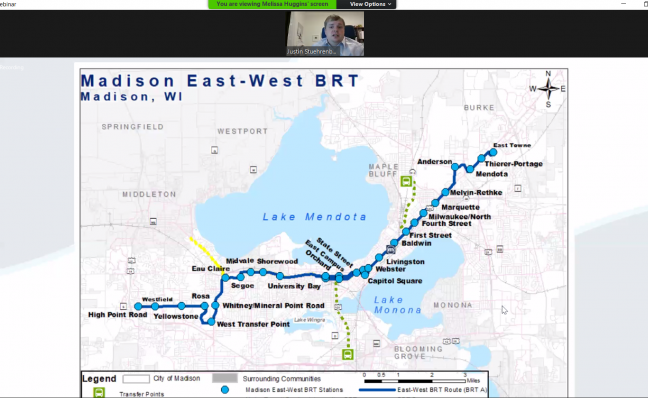Effects of the COVID-19 pandemic, protests and increased online shopping in the past year have hit State Street particularly hard, and as a result, many businesses have found solace in plans to increase bus traffic to the area.
Since the start of the pandemic, Metro Transit has reduced its presence on State Street by 30%, City of Madison Director of Transportation Tom Lynch said.
Lynch said in addition to scaling back at the start of the pandemic, Metro Transit proposed route changes to reduce current buses on State Street by another 25 to 30%. During the evening peak, almost 40% fewer buses would pass through.
Lynch said the city worked to reduce Metro Transit’s presence around State Street in order to make room for the city’s new Bus Rapid Transit system, which it will implement over the next few years, Lynch said.
“State Street businesses will benefit from the Bus Rapid Transit system with a five-to-10-minute frequency,” Lynch said. “We do support our city businesses, and we do want them to thrive.”
The BRT system will connect businesses on State Street to Madison’s east and west sides, Lynch said.
President of Downtown Madison Inc. James Ilstrup said the city founded BRT in order to better connect the city’s economy.
“The whole point of Bus Rapid Transit is to get places more quickly, to speed up the service,” Ilstrup said. “The buses stop less frequently, they have raised platforms for people to get on and off, you prepay — the whole point is to turn it into a subway above ground.”
Ilstrup said faster routes will help many Madison residents, including working people, students at the University of Wisconsin and others, explore the downtown area.
The BRT investment is the most significant transportation investment made by the city in decades, with a $160 million price tag attached, Lynch said.
“Transit is really our long-range plan, and we want it to go to the main places,” Lynch said.
BRT will reduce roadway congestion, creating an environment with less single-person vehicles on the road, Lynch said. On specific roads that cannot add more lanes, Lynch said this adjustment will be especially noticeable, with much less congestion.
By removing more Metro Transit routes from State Street and replacing them with a faster, electric BRT bus system, Lynch said the city will give residents an environment with equitable access to transportation.
“We want State Street to be a location that is accessible to all, particularly those without a car,” Lynch said. “Transit riders are disproportionately people of color and people without a car, so keeping some buses on State Street provides that access.”
Lynch said officials floated the idea of removing all buses from the State Street area and creating a pedestrian mall.
Lynch said even large pedestrian malls, however, need transit systems. For example, in Times Square, pedestrians use the subway system as their form of transit to easily access the area, Lynch said.
Even if the city converted State Street into a pedestrian mall, Lynch said they would only be able to add two feet to each side of the street in order to comply with fire-lane requirements.
“A 20-foot fire lane that is free from furniture and other obstructions still would need to be present on State Street,” Lynch said. “The width of this fire lane cannot be reduced.”
Ilstrup said though the city could move buses off State Street with relative ease, this move would only address one potential fire hazard.
The community would need to address a plethora of logistical factors in order to open up space to move fire trucks downtown and create delivery access, Ilstrup said.
But Ilstrup said it will prove difficult to keep enough buses running to make the area accessible while also making their presence less visible.
“It’s a better experience on State Street with less buses. With the fumes and the noise, it’s just a better experience with less bussing,” Ilstrup said. “The plan really helps kill two birds with one stone.”
Lynch said eliminating bus activity from State Street could present other safety challenges as well. Lynch said the absence of buses and riders may attract illicit activity and patrolling the State Street area would become more difficult.
Upon weighing the pros and cons of the system, Lynch said he believes BRT will unlock many benefits for Madison residents and businesses in the downtown area.
“Bus Rapid Transit systems, when they’ve been implemented in other cities, have been transformative,” Lynch said. “We really believe transit should be our front door, not our back door.”


